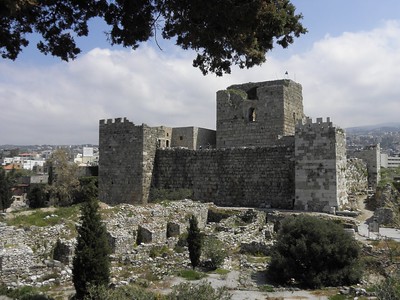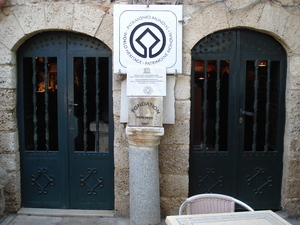Byblos

Byblos was an early Phoenician settlement and maritime commercial city, associated with the history of the diffusion of the Phoenician alphabet.
The town is believed to have been founded around 5,000 BCE, making it one of the oldest continuously inhabited sites in the world. Phoenician remains on-site include the Great Temple, the Temple of Baalat Gebal, and the Temple of the Obelisks. The archeological site holds successive layers of remains from the neolithic, chalcolithic, Assyrian, Roman, Byzantine, Muslim, and Crusader periods. The site also includes the current town of medieval and Ottoman origin.
Community Perspective: Byblos is the most touristy of Lebanon’s WHS and it has a pleasant coastal Mediterranean setting. The Crusader Castle is the dominant feature.
Map of Byblos
Community Reviews
Philipp Peterer

Visit: January 2019. Byblos is a good place to start a Lebanon WHS trip. I arrived at night, after an easy 45min drive from Beirut airport. Be aware that the same trip during the day can take 2-3 times longer due to heavy traffic in and around Beirut. To add another bonus, accommodation in Byblos was also cheaper and I could park my car in front of the hotel, close to the core zone.
The site opened at 8am and I must say I really liked it. As usual, I was the first visitor on site and enjoyed unspoiled views over the area. I can’t add much about what to see within the archeological zone. It’s a mix of remains from different cultures and times with the Crusader Castle as the dominant feature. It took me around 2 hours to see it all.
Outside the ticketed zone there is a tiny fort at the harbor and a roman street with columns in the new part of the town. They are both within walking distance. The “old souq” is very small and rather a zone for restaurants. The town is very touristy, so you won’t have trouble finding food or an ATM.
From Byblos you can easily reach several TWHS (Batroun, Tripoli) and the Qadisha Valley.
Martina Rúčková

Byblos is one of the towns that, along with likes of Jericho, Damascus, Plovdiv and Athens claim to be the oldest continously inhabited cities of the world. As far as Lebanon goes, it's the easiest one to visit, a chilled under-an-hour drive up north from Beirut. Well, as long as you won't get stuck in traffic jams, that are especially painful in the evenings (we enjoyed them on our way back). The town is very touristy and milking its potential to the last drop. There's a free parking spot that's well signposted, or, if you fancy yourself very lazy, you can make use of the vallet parking right by the entrance, we spent about 3 euros on that.
The site itself is pretty, but a bit of a mishmash of everything: a crusader castle with lovely views from the top and then Roman ruins. Including one of the smallest theatres I've seen. The site is quite extensive, you can choose which parts to explore. There are signposts in multiple languages around. The castle doubles as the museum with some excavated exhibits. It's the most touristy of Lebanese WHSs, many people around, so visit early to beat the crowds. We visited en route from Qadisha valley, used the offline maps as the highway exit and the whole road is not that well signposted. Oh and if you want to stock up on souvenirs, this is the place to do so.
Els Slots

Although Byblos (nowadays known as ‘Jbeil’) lies only 35 km north of Beirut, it took the rickety local bus number 6 more than 1.5 hours to get me there. As always in Beirut we got stuck in traffic, and then slowly proceeded through casino-town Jounieh until we reached the Mediterranean. Finally, we were leaving the highrise buildings and American fast food restaurants behind. The drive northwards along the coast is quite pleasant, though many good spots have been taken over by large beach hotels and exclusive fish restaurants. The bus driver dumped me at an overpass, from where I walked down into the city center of Byblos.
It is not difficult to find your way to the archeological site: just walk to the Crusader Castle, which is the highest building in the area. After paying the ´foreigners´ entrance fee of 8000 LBP (4 EUR), I started the long circuit of the complex. Paths lead to all corners of the site, with information boards in English, French, and Arabic to explain what once was here. The origins of Byblos lie in the neolithic and chalcolithic, so remains of this period are limited. Better preserved is the Roman heritage: a small theatre at a splendid location overlooking the sea, and a row of columns along a former Roman road. At the far end of the complex lies the Temple of the Obelisks, an Egyptian/Phoenician construction. A group of obelisks still is standing upright, which makes it look like a cemetery.
My walk ended at the Castle – the first Crusader Castle I have ever been to. I admired its sturdy construction. Inside a museum covers two of its floors. The best pieces that were found in Byblos are shown in the Lebanese National Museum: the sarcophagus with the first Phoenician writing, the colossal Egyptian-looking Bronze Age statue that dominates the main hall, the little delicate, flat bronze statues that were used as votive offerings.
I spent about 1.5 hours on-site, and enjoyed walking around it slowly. It was the busiest tourist site I have visited so far in Lebanon: there were about 30-40 other people, most of them in small tour groups. Before taking the bus back to Beirut, I had another good Lebanese lunch at Fenicia restaurant near the souk.
Solivagant

Byblos is apparently/claims to be the “oldest continuously inhabited town in the world”. The “idea” is however more impressive than the reality. It is a pleasant enough town with bustling little harbour overlooked by the remains of a crusader castle (photo) – much like many a small town around the Mediterranean. On the hill by the castle there is an archaeological site with a range of ruins from Roman times going back to Bronze Age and Neolithic but in all honesty there is not a lot to see. If you have made it to Lebanon however you should go up there – it is an easy trip out of Beirut either as part of a circuit up to the Cedars of Lebanon or as a return trip. It is all very relaxed and there are some good restaurants and pleasant cafes.
Community Rating
- : Milan Jirasek Juropa Persian Globetrotter Dutchnick Rvieira Errol Neo Jeffrey Chai Ran
- : Hanming Rodinia
- : Thomas Buechler Philipp Peterer George Gdanski Christravelblog Fmaiolo@yahoo.com Ammon Watkins Juha Sjoeblom
- : Szucs Tamas Alexander Lehmann Philipp Leu Vernon Prieto MoPython Bergecn Els Slots
- : Tarquinio_Superbo Thomas van der Walt Svein Elias Drazsika Riomussafer Little Lauren Travels Martina Rúčková Lukasz Palczewski Christoph Randi Thomsen
- : Solivagant Alexander Barabanov Joyce van Soest Zoë Sheng João Aender Ivan Rucek
- : Krijn
- : Walter
- : Gabor
Site Info
- Full Name
- Byblos
- Unesco ID
- 295
- Country
- Lebanon
- Inscribed
- 1984
- Type
- Cultural
- Criteria
-
3 4 6
- Categories
- Urban landscape - Arabic and Middle Eastern
- Link
- By ID
Site History
1984 Inscribed
Site Links
Unesco Website
Official Website
Related
In the News
Connections
The site has 26 connections
Constructions
History
Human Activity
Individual People
Religion and Belief
Timeline
Trivia
Visiting conditions
WHS Hotspots
WHS on Other Lists
Visitors
161 Community Members have visited.
